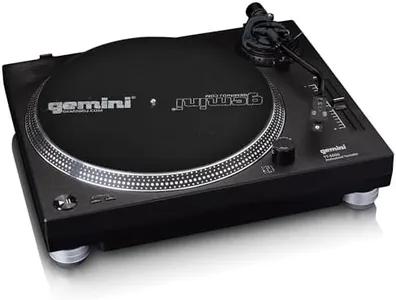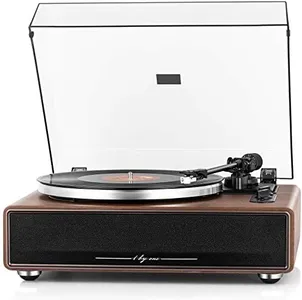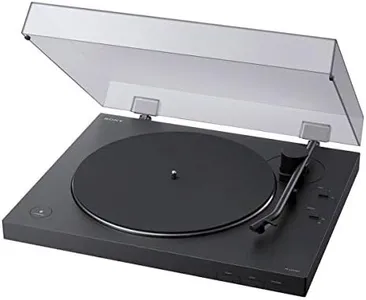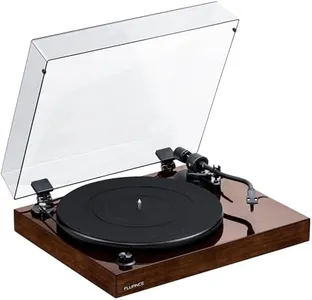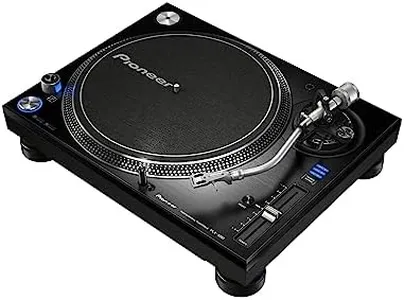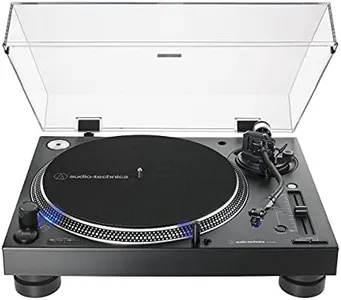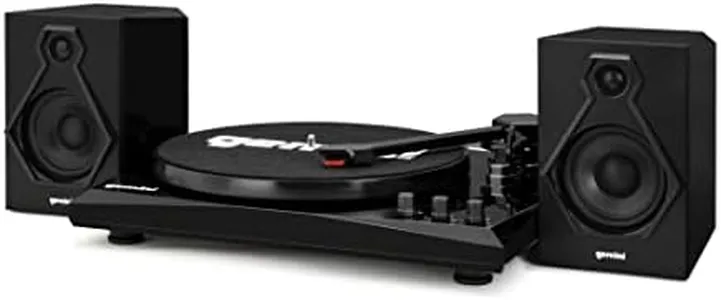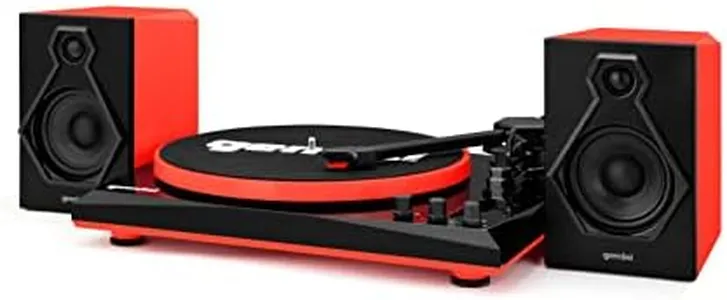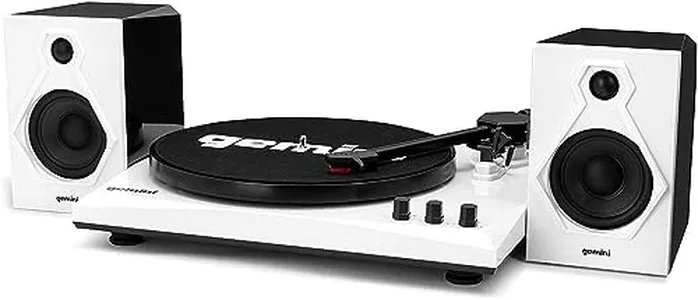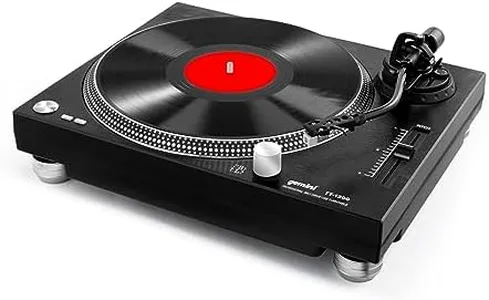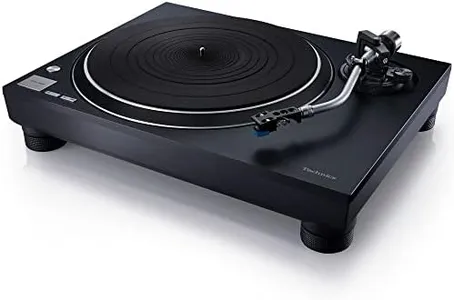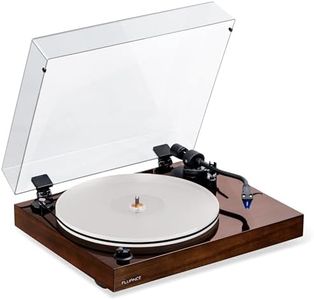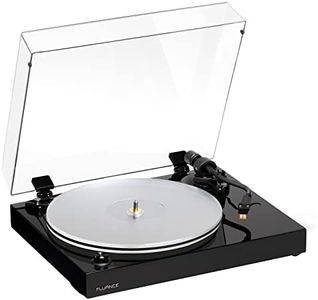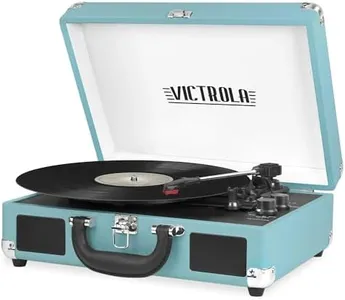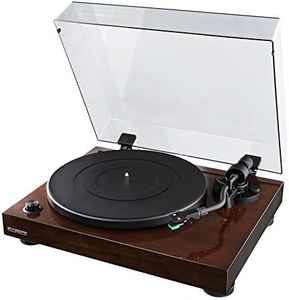10 Best Turntables 2025 in the United States
Our technology thoroughly searches through the online shopping world, reviewing hundreds of sites. We then process and analyze this information, updating in real-time to bring you the latest top-rated products. This way, you always get the best and most current options available.

Our Top Picks
Winner
1 by ONE High Fidelity Belt Drive Turntable with Built-in Speakers, Vinyl Record Player with Magnetic Cartridge, Bluetooth Playback and Aux-in Functionality, Auto Off
The 1 by ONE High Fidelity Belt Drive Turntable offers a mix of modern features and classic turntable essentials. Its belt drive system is known for reducing vibrations, which can enhance sound quality. The turntable has a stylish appearance, crafted from wood and metal, giving it a sophisticated look that could complement any room decor. It supports both 33 and 45 RPM speeds, making it versatile for different types of vinyl records. The inclusion of a built-in preamp is convenient for users who do not want to invest in additional audio equipment.
Additionally, the turntable comes with built-in speakers, making it a great all-in-one solution for those starting their vinyl journey or looking for a space-saving setup. The magnetic cartridge and adjustable counterweight help produce rich and warm audio, assisted by the Audio-Technica stylus, known for its precision and clarity. This turntable also features Bluetooth connectivity, allowing you to stream music from various devices, adding to its versatility.
However, the built-in speakers might not satisfy audiophiles looking for high-end sound quality, and users may eventually want to connect external speakers for a better audio experience. Weighing 13.2 pounds, it is relatively portable but not the lightest option available. The auto-off feature is a handy addition, ensuring the turntable doesn't run needlessly. This turntable is ideal for beginners and casual listeners who appreciate a blend of classic and modern functionalities, but it might not fully satisfy seasoned audiophiles seeking premium sound quality.
Sony PS-LX310BT Belt Drive Turntable: Fully Automatic Wireless Vinyl Record Player with Bluetooth and USB Output Black
Most important from
3667 reviews
The Sony PS-LX310BT is a belt-drive turntable that offers a blend of modern features and classic vinyl playback. Its fully automatic operation makes it very user-friendly, with one-step auto start, stop, and return functions. This model supports two speeds, 33⅓ and 45 RPM, accommodating most vinyl records. The aluminum die-cast platter helps in reducing vibrations, enhancing audio clarity. Additionally, the newly designed straight tonearm ensures better tracking and playback quality.
This turntable includes a built-in, switchable phono preamp with three gain settings, allowing it to connect to any audio system, and offers both phono and line outputs. For digital enthusiasts, the USB ripping feature enables vinyl to MP3 conversion, while Bluetooth connectivity allows wireless streaming to speakers or headphones, making it very versatile. However, the platter is made of aluminum, while the build material is plastic, which might not be as durable as some higher-end models.
Weighing 7.9 pounds, it is relatively portable, but the plastic construction might not feel as robust. The turntable comes with various accessories, including a dust cover, RCA cables, and a USB B cable, making it ready to use out of the box. Ideal for both beginners and casual listeners who appreciate convenience and modern features, the Sony PS-LX310BT provides a good balance of quality and functionality.
Most important from
3667 reviews
Fluance RT82 Reference High Fidelity Vinyl Turntable Record Player with Ortofon OM10 Cartridge, Speed Control Motor, High Mass MDF Wood Plinth, Vibration Isolation Feet - Walnut
Most important from
1316 reviews
The Fluance RT82 turntable offers a high-fidelity vinyl listening experience with its pure analog performance and exceptional musical accuracy. Featuring an Ortofon OM10 elliptical cartridge, it delivers dynamic sound with reduced distortion and enhanced channel separation. The precision speed control motor ensures consistent playback, and the MDF wood plinth with vibration isolation feet helps minimize unwanted vibrations for clear audio. The balanced S-shaped tonearm aids in accurate groove tracking for detailed sound reproduction.
However, it lacks a built-in preamp, which means you'll need an external phono preamplifier to connect it to your sound system. Additionally, it does not have USB connectivity, so digitizing your vinyl records is not an option with this model.
Despite these drawbacks, the Fluance RT82 is a solid choice for analog enthusiasts looking for a turntable with excellent build quality and sound performance.
Most important from
1316 reviews
Buying Guide for the Best Turntables
Choosing the right turntable can greatly enhance your music listening experience. Whether you're a casual listener or an audiophile, understanding the key specifications of turntables will help you make an informed decision. Here are the main factors to consider when selecting a turntable that best fits your needs.FAQ
Most Popular Categories Right Now
